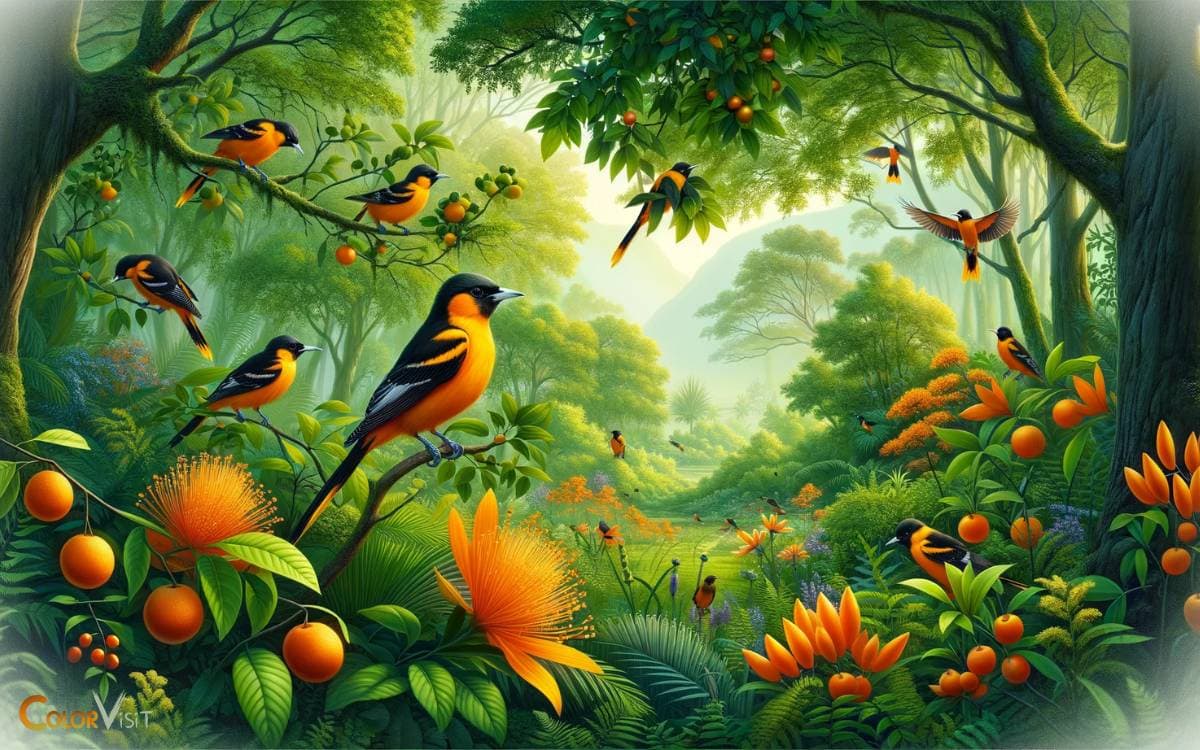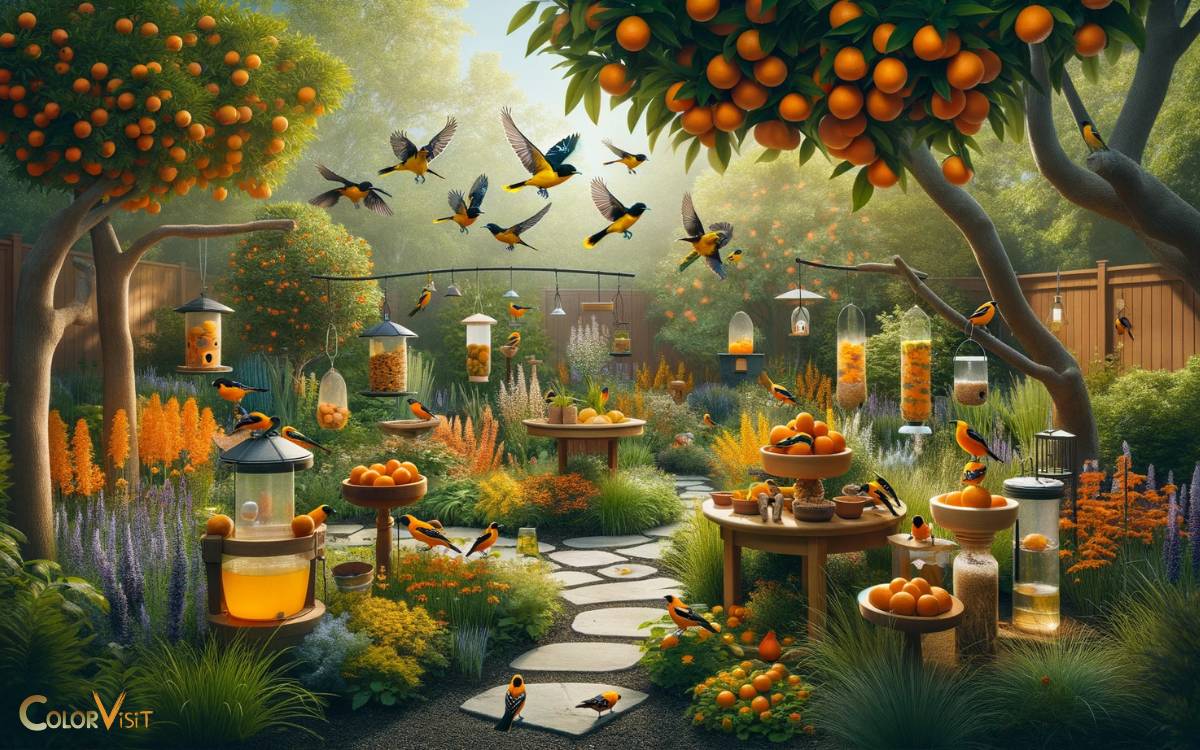Are Orioles Attracted to the Color Orange? Yes!
Yes, orioles are indeed attracted to the color orange. This fascination with orange among these vibrant birds is not just a matter of folklore; it is well-supported by observations from bird watchers and ornithologists alike.
The attraction to orange objects, including feeders and flowers, might be tied to several factors, including evolutionary preferences, the search for food, and the visibility of the color in their natural habitat.
Orioles have a natural inclination towards bright colors, especially orange, which plays a significant role in their behavior for several reasons:
A common practice among oriole enthusiasts is to hang orange slices on trees or provide feeders with orange elements.
This simple method has proven effective in attracting orioles, offering a delightful viewing experience of these beautiful birds.
Factors Attracting Orioles to Orange:
- Visibility in natural habitat
- Evolutionary predisposition towards orange-colored food sources
- Association of orange with sugary fruits and nectar
By incorporating orange elements into your backyard, you’re not just attracting orioles; you’re participating in a fascinating aspect of avian behavior that highlights the intricate relationship between wildlife and their environment.
Key Takeaway
The Orioles’ Color Preference
Numerous studies have demonstrated that Orioles exhibit a marked preference for the color orange, a phenomenon that likely stems from their natural feeding behaviors and ecological interactions.
This inclination is not merely anecdotal but has been quantitatively assessed through controlled experiments, wherein objects or feeders of various colors were presented, consistently revealing an orange bias.
This preference has profound implications for ornithological studies, suggesting an evolutionary adaptation possibly linked to the visual acuity of these birds and their foraging strategies.
Understanding this color preference not only enriches our knowledge of Oriole behavior but also informs conservation efforts and habitat management.
Why Orange Appeals to Orioles
The appeal of the color orange to Orioles is rooted in their natural instincts and the critical role visual signals play in their feeding behavior.
Research suggests that Orioles are biologically predisposed to associate the color orange with sources of nourishment, a preference that likely enhances foraging efficiency.
This intrinsic attraction facilitates their identification and selection of food resources, underscoring the importance of color cues in their ecological interactions.
Orioles’ Natural Instincts
A significant factor contributing to the attraction of orioles to the color orange lies in their innate foraging behaviors and ecological adaptations.
These birds have evolved over millennia to seek out specific hues in their environment, correlating highly with the availability of food resources and nesting materials.
The preference for orange, therefore, is not merely aesthetic but deeply ingrained in their survival strategies.
This instinctual behavior showcases a fascinating intersection of natural selection and ecological necessity, driving orioles towards environments where they can thrive.
| Behavior Aspect | Relation to Orange |
|---|---|
| Foraging Efficiency | Enhanced by bright colors |
| Predator Avoidance | Camouflage among orange flora |
| Mating Signals | Attraction to vibrant displays |
| Resource Identification | Quick spotting of nourishment |
| Habitat Selection | Preference for vibrant ecosystems |
Visual Signals for Feeding
Understanding the appeal of the color orange to orioles begins with recognizing its prominent role in their feeding behavior. It serves as a visual beacon to locate nourishment efficiently in their natural habitats.
This attraction is not arbitrary but deeply rooted in evolutionary adaptations that optimize foraging efficacy.
Orioles, being visually oriented avians, have developed a keen sensitivity to wavelengths in the orange spectrum. This sensitivity correlates highly with the visibility of ripe fruits and abundant nectar sources, their primary food sources.
This chromatic preference is a survival mechanism that enables them to discern and prioritize high-yield feeding areas swiftly.
Consequently, the color orange acts as a critical signal within their ecological niche. It guides them towards areas of concentrated nutritional value, thus enhancing their foraging strategies and overall fitness.
The Science Behind the Attraction
The scientific exploration into why orioles are attracted to the color orange begins with an understanding of their color perception capabilities.
Research indicates that the wavelength of light reflected by orange objects aligns closely with the visual sensitivity spectrum of orioles, rendering this color particularly conspicuous to them.
Consequently, this heightened visibility likely triggers behavioral responses in orioles, such as increased investigation and interaction with orange objects, suggesting an innate attraction mechanism.
Color Perception in Orioles
Orioles exhibit a distinct preference for the color orange, a phenomenon rooted in their unique visual perception system.
This inclination is not arbitrary but is underpinned by evolutionary adaptations that enhance their survival and reproductive success.
The color orange, vivid and conspicuous in the natural environment, likely plays a significant role in their foraging and mating behaviors.
Key aspects of the oriole’s visual system include:
- Tetrachromatic Vision: Orioles possess four types of cone cells in their eyes, allowing them to perceive a broader spectrum of colors, including ultraviolet light.
- Heightened Sensitivity: Their retinas are finely tuned to detect wavelengths associated with the color orange.
- Color Discrimination: This capability facilitates the identification of ripe fruits and nutritious flowers.
- Contrast Enhancement: Orioles can distinguish orange hues against a green foliage background, optimizing foraging efficiency.
These features collectively elucidate the scientific basis for orioles’ attraction to the color orange, demonstrating a sophisticated intersection of biology and behavior.
Orange: A Natural Magnet
Having established the unique visual capabilities of orioles, it becomes imperative to explore the scientific principles that make the color orange a focal point of attraction for these birds.
Orioles possess an advanced color perception mechanism that enables them to discern a wide spectrum of hues, with a particular sensitivity towards the orange wavelength. This predilection is not arbitrary but deeply rooted in evolutionary biology.
The orange coloration, prevalent in their natural habitat, signals ripe fruits and rich nectar sources, essential for their nutrition and survival.
Consequently, orioles have developed a specialized visual acuity that optimizes their ability to locate these vital resources efficiently.
This biological adaptation is a testament to the intricate relationship between an organism and its environment, showcasing how evolutionary pressures shape sensory capabilities to favor survival advantages.
Behavioral Responses to Orange
Understanding the behavioral responses of orioles to the color orange requires a meticulous examination of their interactions with this hue, which plays a pivotal role in their foraging activities and habitat selection.
The attraction to orange is not merely anecdotal but is grounded in observable, quantifiable behaviors:
- Increased visitation rates to feeders adorned with orange compared to those of other colors.
- Preference for nesting sites in proximity to orange objects, suggesting a perceived enhancement of camouflage or safety.
- Elevated engagement with flora displaying orange pigmentation, aligning with their natural dietary preferences.
- Seasonal shifts in attraction intensity, potentially correlating with breeding cycles and the availability of natural food sources.
This attraction mechanism, deeply embedded in their behavioral ecology, underscores the intricate interplay between avian species and their environment, driving innovative approaches in avian conservation and habitat design.
Orioles in Their Natural Habitat
In their natural habitat, orioles typically reside in open woodlands, particularly favoring areas where deciduous trees are abundant, which provide both nesting sites and a rich source of food.
These environments support a diverse ecosystem, allowing orioles to thrive through a combination of insect consumption and fruit foraging, which varies seasonally.
The strategic selection of habitat underscores their adaptive behaviors and survival strategies.
| Habitat Feature | Importance to Orioles | Impact on Survival |
|---|---|---|
| Deciduous Trees | Nesting & Food Source | High |
| Open Woodlands | Foraging Efficiency | Medium |
| Water Sources | Hydration & Bathing | Medium |
| Insect Abundance | Primary Food Source | High |
| Fruit-Bearing Plants | Secondary Food Source | High |
The Role of Color in Feeding
Color perception plays a pivotal role in the feeding behaviors of orioles, influencing their attraction to specific food sources.
This attraction is not merely a matter of preference but is rooted in the evolutionary adaptations of these birds to their environments.
Orioles have developed a keen ability to identify colors that correlate with ripe, nutritious, and easily accessible food sources.
The significance of color in their feeding habits can be encapsulated in the following points:
- Enhanced visual acuity for certain colors improves foraging efficiency.
- Color preference correlates with the nutritional value of available food.
- Seasonal changes in color perception adapt to available food sources.
- The attraction to bright colors aids in the quick identification of food among foliage.
Understanding these aspects is crucial for innovative approaches in ornithological studies and bird conservation strategies.
How to Use Orange to Attract Orioles
To effectively attract Orioles, the selection of orange feeders plays a pivotal role, capitalizing on the birds’ natural attraction to the color.
Integrating orange-blooming flowers into the local flora not only enhances the aesthetic appeal of gardens but also serves as a magnet for these birds, providing both nectar and an inviting habitat.
Additionally, offering foods that are orange in color, such as sliced oranges or marmalade, can further augment the likelihood of attracting Orioles, aligning with their dietary preferences and visual attractions.
Choosing Orange Feeders
Selecting orange feeders plays a pivotal role in effectively attracting orioles, as these birds exhibit a strong preference for this particular hue.
The visibility and attractiveness of feeders can be significantly enhanced by considering the following factors:
- Spectral Match: Ensure the feeder’s color closely matches the orange spectrum visible to orioles, maximizing visual appeal.
- Material Reflectivity: Opt for materials that enhance the feeder’s luminosity under natural sunlight, aiding in long-distance attraction.
- Design Complexity: Simple, yet innovative designs facilitate easier access and reduce competition, encouraging frequent visits.
- Placement Strategy: Position feeders in locations that provide a clear line of sight, yet are near natural shelters for safety.
Planting Orange-Blooming Flowers
Incorporating orange-blooming flowers into your garden can significantly enhance its attractiveness to orioles, leveraging their natural inclination towards this vivid hue.
Orioles exhibit a strong preference for the color orange, a trait that can be strategically utilized by selecting specific flora that not only meets the aesthetic criteria but also supports the ecological needs of these birds.
Scientifically, the visual spectrum of orioles is finely tuned to detect wavelengths associated with orange and red hues, making plants like Marigolds, Zinnias, and Trumpet Vines ideal candidates for attracting these avian visitors.
These plants not only provide the necessary visual stimulus but also offer nectar and insects, catering to the dietary requirements of orioles.
Thus, a garden orchestrated with such botanical selections creates a habitat that is both visually appealing to humans and functionally supportive of oriole populations.
Offering Orange Foods
Expanding beyond the realm of floriculture, offering orange-colored foods can further entice orioles, capitalizing on their innate attraction to this vibrant color.
The strategic provisioning of orange-hued nourishment aligns with scientific observations, suggesting avian species’ preference for food sources that mimic their natural predilections.
To optimize the attraction of these vibrant avians, consider incorporating:
- Sliced oranges, exposing the bright flesh.
- Halved, ripe persimmons, ensuring accessibility.
- Jelly containers filled with marmalade, avoiding artificial sweeteners.
- Homemade nectar, infused with natural orange dye.
This approach not only mirrors the orioles’ ecological habits but also enhances the likelihood of their prolonged engagement with the provided habitat, offering an innovative method to observe these captivating birds in a controlled environment.
The Best Orange Feeders
To optimize the attraction of Orioles, it is crucial to select feeders that prominently feature the color orange and are designed to accommodate their feeding habits efficiently.
Scientific research suggests that Orioles are visually drawn to the color orange, making feeder color a critical consideration in their design.
Innovative feeder models incorporate not only vibrant orange hues but also structural features tailored to the Orioles’ unique feeding preferences.
These include shallow nectar basins to mimic natural flower structures, and sturdy perches to support their weight.
Additionally, models that facilitate easy cleaning and refilling are preferred to maintain hygiene and attract these birds consistently.
Analytical comparison of feeder effectiveness indicates that those combining visual appeal with functional design significantly enhance the likelihood of attracting Orioles, thus contributing to the success of conservation and observation efforts.
Planting Orange-Flowering Plants
Beyond the selection of vibrant orange feeders, integrating orange-flowering plants into one’s garden presents a natural method to attract Orioles, leveraging their innate attraction to the color.
This approach not only enhances the aesthetic appeal of the garden but also supports the ecosystem by providing natural habitats and food sources for various species.
When selecting orange-flowering plants, consider the following:
- Bloom Period: Opt for species with staggered blooming periods to ensure continuous attraction.
- Nectar Concentration: Select plants known for high nectar production to meet the Orioles’ dietary needs.
- Plant Height: Incorporate a mix of heights to cater to Orioles’ preference for varying feeding levels.
- Native Species: Prioritize native plants to promote local biodiversity and ecosystem health.
This methodical selection process underscores a strategic approach to garden planning, aimed at creating an inviting environment for Orioles while fostering an ecologically balanced outdoor space.
The Importance of Location
Choosing an optimal location for planting orange-flowering plants is a critical factor in effectively attracting Orioles to your garden.
Scientific analysis reveals that Orioles exhibit a preference for areas that mimic their natural habitat, characterized by open spaces with scattered trees and shrubs.
This predilection suggests that gardens designed to emulate such environments are more likely to attract these vibrant birds.
Furthermore, positioning these orange-flowering plants in locations that receive ample sunlight can boost their visibility and appeal to Orioles, as these birds are drawn to bright, conspicuous colors.
Additionally, proximity to water sources can enhance the location’s attractiveness, as Orioles, like many bird species, seek environments where water is readily accessible.
This strategic approach to selecting a planting location integrates avian behavioral patterns with environmental considerations, optimizing the potential for attracting Orioles.
Orioles’ Diet and Orange Foods
Understanding the dietary preferences of Orioles reveals a notable affinity for orange-colored foods, which play a significant role in their feeding habits.
This preference can be attributed to several factors, including the visual appeal of orange hues and the nutritional content of these foods.
Orioles, primarily frugivorous, exhibit a particular partiality towards:
- Ripe, orange-hued fruits such as oranges and apricots.
- Nectar from brightly colored flowers, often favoring those of an orange pigment.
- Insects that inhabit or are visible against orange flora.
- Jelly, especially when tinted orange or resembling the color and sugar content of natural fruits.
This dietary inclination not only influences their foraging behavior but also suggests a fascinating ecological interaction between Orioles and their environment, underscoring the importance of color in avian nutrition and habitat selection.
Making Your Yard Oriole-Friendly
Given the Orioles’ pronounced preference for orange-colored foods, it becomes imperative to consider how this dietary inclination informs strategies for creating an Oriole-friendly yard.
Integrating this preference implies planting flora that blooms or bears fruit in vivid orange hues, such as trumpet vines and milkweed, to naturally attract these birds.
Moreover, incorporating feeders specifically designed to dispense nectar, jelly, or pieces of fruit enhances the appeal of a yard to Orioles.
Scientifically, the juxtaposition of orange feeders against a green foliage backdrop increases visibility, leveraging the Orioles’ visual acuity for this spectrum.
This approach not only caters to their dietary needs but also provides a habitat conducive to their nesting and foraging behaviors, establishing a symbiotic relationship between homeowners and the local Oriole population.
Observing Orioles in the Wild
Observing Orioles in their natural habitat requires a keen eye and knowledge of their preferred environments, which often include open woodlands, forest edges, and areas abundant in fruit-bearing vegetation.
To effectively study these birds, one must consider several key aspects:
- Seasonal migration patterns, as Orioles are more visible during specific months.
- The variety of vocalizations they use, which can indicate their presence even when they are not directly visible.
- Behavioral cues, such as foraging methods and interactions with other bird species, which can provide insights into their ecological roles.
- The impact of environmental changes on their habitats and how these changes influence their visibility and behavior.
This analytical approach facilitates a deeper understanding of Orioles, contributing to both scientific knowledge and innovative birdwatching practices.
Tips for Photographing Orioles
Having established a foundation in observing Orioles in their natural settings, the next step is to explore effective strategies for photographing these vibrant birds, ensuring that both amateur and professional ornithologists can capture their beauty and behaviors accurately.
Optimal photography of Orioles necessitates a blend of patience, precision in timing, and technological adeptness.
Utilizing high-resolution lenses capable of rapid focus adjustments is paramount, as Orioles are notably swift and may only perch briefly. Employing a tripod stabilizes the camera, significantly enhancing image sharpness.
Furthermore, mastering manual exposure settings is crucial; adjusting shutter speed to freeze motion, alongside aperture settings to blur backgrounds, accentuates the bird’s vivid plumage.
Lastly, leveraging natural light conditions, particularly during golden hours, can dramatically elevate the aesthetic quality of photographs, capturing the iridescent orange hues with striking clarity and depth.
Conclusion
The vibrant hue of orange acts as a beacon, drawing orioles much like moths to a flame. This attraction, rooted in evolutionary adaptations and dietary preferences, underscores the significant role color plays in the natural world.
By understanding and harnessing this preference, individuals can create environments that are not only oriole-friendly but also contribute to the conservation and appreciation of these vivid avian creatures.
Through scientific inquiry and observation, the intricate tapestry of nature’s color code continues to be unraveled.














